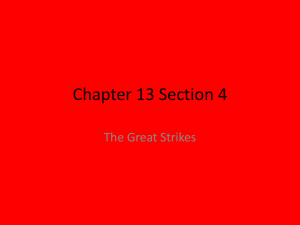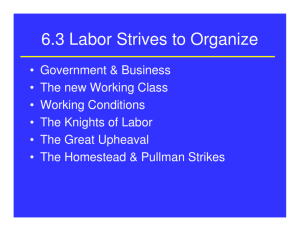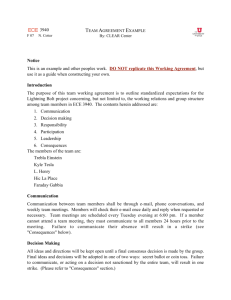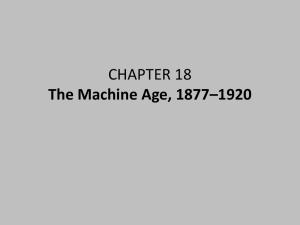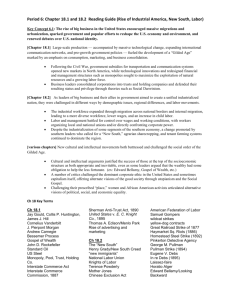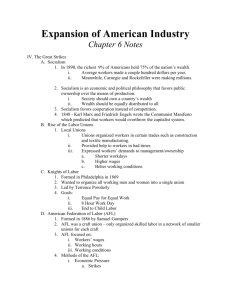The Gilded Age Outline
advertisement
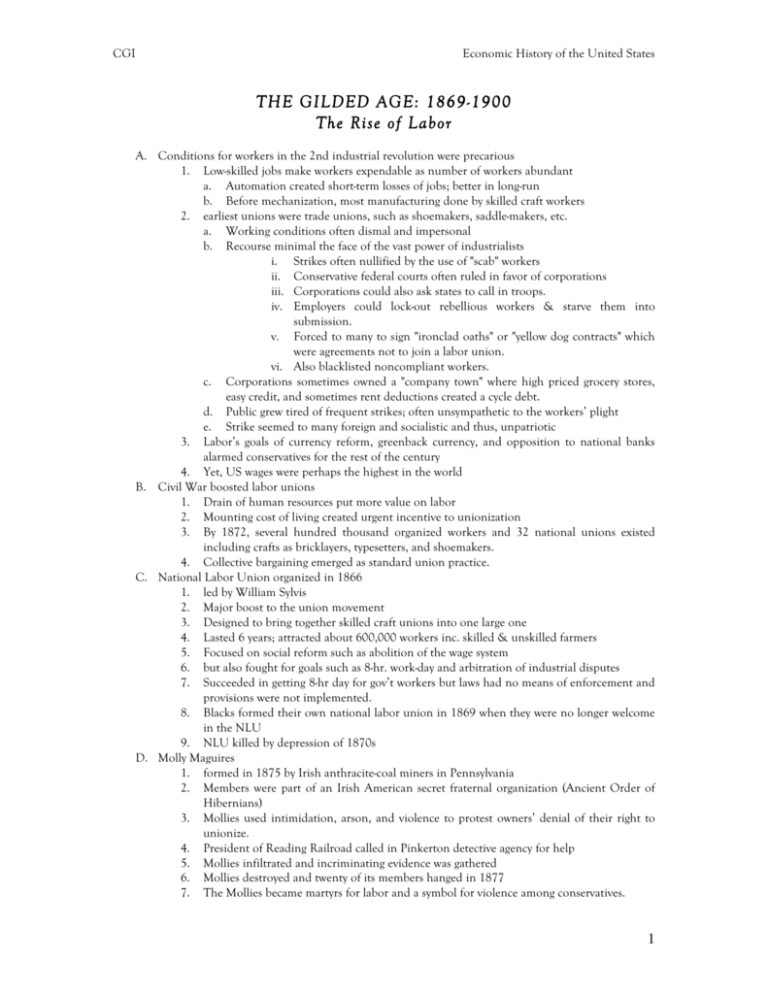
CGI Economic History of the United States THE GILDED AGE: 1869-1900 The Rise of Labor A. Conditions for workers in the 2nd industrial revolution were precarious 1. Low-skilled jobs make workers expendable as number of workers abundant a. Automation created short-term losses of jobs; better in long-run b. Before mechanization, most manufacturing done by skilled craft workers 2. earliest unions were trade unions, such as shoemakers, saddle-makers, etc. a. Working conditions often dismal and impersonal b. Recourse minimal the face of the vast power of industrialists i. Strikes often nullified by the use of "scab" workers ii. Conservative federal courts often ruled in favor of corporations iii. Corporations could also ask states to call in troops. iv. Employers could lock-out rebellious workers & starve them into submission. v. Forced to many to sign "ironclad oaths" or "yellow dog contracts" which were agreements not to join a labor union. vi. Also blacklisted noncompliant workers. c. Corporations sometimes owned a "company town" where high priced grocery stores, easy credit, and sometimes rent deductions created a cycle debt. d. Public grew tired of frequent strikes; often unsympathetic to the workers’ plight e. Strike seemed to many foreign and socialistic and thus, unpatriotic 3. Labor’s goals of currency reform, greenback currency, and opposition to national banks alarmed conservatives for the rest of the century 4. Yet, US wages were perhaps the highest in the world B. Civil War boosted labor unions 1. Drain of human resources put more value on labor 2. Mounting cost of living created urgent incentive to unionization 3. By 1872, several hundred thousand organized workers and 32 national unions existed including crafts as bricklayers, typesetters, and shoemakers. 4. Collective bargaining emerged as standard union practice. C. National Labor Union organized in 1866 1. led by William Sylvis 2. Major boost to the union movement 3. Designed to bring together skilled craft unions into one large one 4. Lasted 6 years; attracted about 600,000 workers inc. skilled & unskilled farmers 5. Focused on social reform such as abolition of the wage system 6. but also fought for goals such as 8-hr. work-day and arbitration of industrial disputes 7. Succeeded in getting 8-hr day for gov’t workers but laws had no means of enforcement and provisions were not implemented. 8. Blacks formed their own national labor union in 1869 when they were no longer welcome in the NLU 9. NLU killed by depression of 1870s D. Molly Maguires 1. formed in 1875 by Irish anthracite-coal miners in Pennsylvania 2. Members were part of an Irish American secret fraternal organization (Ancient Order of Hibernians) 3. Mollies used intimidation, arson, and violence to protest owners’ denial of their right to unionize. 4. President of Reading Railroad called in Pinkerton detective agency for help 5. Mollies infiltrated and incriminating evidence was gathered 6. Mollies destroyed and twenty of its members hanged in 1877 7. The Mollies became martyrs for labor and a symbol for violence among conservatives. 1 CGI Economic History of the United States E. Great Railroad Strike (1877) 1. Several railroads informed workers wages to be cut by 10% for 2nd time since 1873. 2. First nationwide strike 3. Paralyzed railroads throughout the East and Midwest and idled some 100,000 workers. a. Later, farmers, coal miners, craft workers, & the unemployed joined in b. Involved 14 states and ten railroads. 4. President Hayes sanctioned use of federal troops in PA a. set precedent for future federal intervention b. Led to over 100 deaths and terrified propertied classes. 5. The strike inspired support for the Greenback-Labor party in 1878 and Workingmen’s parties in the 1880s. F. Knights of Labor seized the torch of the defunct NLU 1. Background a. Led by Terence Powderly – a moderate; not a radical b. Founded in 1869 as a secret society (like the Masons and others) 2. Officially known as The Noble and Holy Order of the Knights of Labor a. Secrecy continued through to 1881 to forestall possible reprisals by employers b. Used republican imagery associated with Lincoln that each man should have a say in the political & economic issues that affected him c. Much of leadership and membership was Irish 3. Sought to include all workers in "one big union" including blacks & women a. Excluded only liquor dealers, gamblers, lawyers, bankers, and stockbrokers b. Industrial unionism idea was ahead of its time (not seen until 1930s) c. Most 19th c. unions were trade unions with skilled workers 4. Campaigned for economic and social reform a. Producers’ cooperatives and codes for safety and health b. end to child labor i. Cooperative idea paralleled the Grange in the west ii. Sought to replace wage system with all workers owning factories c. Fought for i. an 8-hr workday through winning a number of strikes, ii. higher pay and equal pay for women. iii. Government regulation of railroads iv. postal savings banks v. gov’t paper currency vi. Sought arbitration rather than industrial warfare. vii. Discouraged strikes and violence as a means for change viii. Powderly’s ban on strikes would be ignored and lead to the Knight’s demise d. Won major strike in 1885 against Gould’s struggling railroads e. Victory increased Knight’s membership to more than 700,000 in 1886. 5. Demise due to the Great Upheaval (1886) a. 1,400 strikes involving 500k workers. b. Knights seen as huge organization that could throw econ. into chaos c. Involvement in a number of May Day strikes in 1886 resulted in 50% failure d. Haymarket Square Bombing in Chicago i. May 4, 1886, Chicago police advanced on a meeting called to protest alleged brutalities by the authorities in May Day strikes ii. Alleged German anarchists present who advocated a violent overthrow of gov't iii. A dynamite bomb was thrown in the crowd that killed 8 police; 60 officers injured by police fire; 7 or 8 civilians killed; 30-40 wounded iv. Resulted in the first full-blown red scare in Chicago for 2 months. 2 CGI Economic History of the United States v. Five anarchists sentenced to death and three others given stiff prison sentences although nobody could prove they had anything to do with the bombing vi. In 1892, Gov. John P. Altgeld, a German-born Democrat pardoned the 3 survivors after exhaustive study of the Haymarket case vii. Defeated for reelection probably due to a conservative backlash. e. The rise of Workingmen’s parties in various cities scared conservatives who blacklisted members through employers’ associations f. Employees had to sign "yellow dog" contracts or take "iron clad" oaths g. Knights of Labor became mistakenly associated with anarchists h. 8-hr movement suffered and subsequent strikes met with many failures i. Inclusion of both skilled and unskilled workers proved a fatal handicap i. Unskilled labor could easily be replaced with "scabs." ii. High-class craft unionists enjoyed a superior bargaining position iii. Became frustrated with giving up their bargaining advantage due to the failure of unskilled labor strikes iv. Powerly’s cautious leadership squandered rank-and-file mobilization by opposing strikes and forbidding political action. v. Skilled craftsmen sought a union of exclusively skilled craft unions j. By 1890s, Knights of Labor had only 100,000 members left who ultimately left to join other protest groups G. American Federation of Labor (AFL) 1. Formed in 1886 under the leadership of Samuel Gompers 2. Consisted of an association of self-governing national unions with the AFL unifying overall strategy. 3. Gompers’ path fairly conservative; bitter foe of socialism; non-political a. Accepted existence of two conflicting classes: workers and employers. b. Only wanted labor to win its fair share; better wages and hours, and improved working conditions ("bread and butter" issues) c. Did, however, attempt to persuade members to vote for favorable candidates 4. Closed shop a. all workers in a unionized industry had to belong to the union. b. Provided necessary funds to ride out prolonged strikes. 5. Chief strategies of AFL: walk-out and boycott a. By 1900, about 500,000 members (critics called it the "labor trust") b. Shortcomings: did not represent unskilled labor esp. women and blacks. H. Major strikes in the 1890s 1. Homestead Strike, 1892 a. in Carnegie’s steel plant near Pittsburgh b. Demonstrated a strong employer could break a union if it hired a mercenary police force and gained gov’t and court protection. c. Frick & Carnegie announced 20% pay slash for steelworkers d. Amalgamated Association of Iron, Steel, and Tin Workers went on strike and Frick then locked them out e. Led to worker uprising – factory surrounded; scabs not allowed through lines f. Frick called in 300 Pinkerton detectives. i. Armed strikers forced their assailants to surrender after 9 Pinkertons and 7 workers were killed and about 150 wounded. ii. PA governor brought in 8,000 state militia and scabs replaced workers. iii. In Sept. scores of workers indicted on 167 counts of murder, rioting, and conspiracy; jury eventually found the leaders innocent g. Union was effectively broken 2. Pullman Strike, 1894 3 CGI Economic History of the United States a. I. Pullman Co. responded to the Great Railroad Strike of 1877 by building a model company town for his workers near the factory in Chicago b. Pullman Palace Car Company hit hard by the depression & cut wages by 1/3 but maintained rent prices in the company town c. Eugene V. Debs helped to organize the American Railway Union of about 150K i. Workers went on strike and even overturned some Pullman cars ii. Railway traffic from Chicago to Pacific Coast paralyzed. d. Attorney General Richard Olney sent federal troops stating strikers interfering with transit of U.S. mail. i. President Cleveland: "If it takes the entire army and navy to deliver a postal card in Chicago, that card will be delivered" ii. Troops sent in over Governor Altgeld’s objections and violence spread to several states costing 34 lives. iii. Strike crushed and 150,000 ARU destroyed. e. Debs and his lieutenants sentenced to 6 mos. jail time for contempt of court f. Debs used his time to read radical literature which laid a philosophical foundation for his later leadership of the Socialist movement in U.S. g. First time gov’t used an injunction to break a strike i. The gov’t made striking, an activity not previously defined as illegal, a crime ii. Labor cried "gov’t by injunction" iii. Laborites held in contempt of court could be imprisoned w/o jury trial. iv. Populists & other debtors concerned as Pullman episode proof of an alliance between big business and the courts 3. Between 1881-1900, 23,000 strikes occurred involving 6.6 million workers. a. Biggest weakness: only represented about 3% of all working people. b. Public finally began to accept workers’ right to organize, bargain collectively, and strike c. Labor Day made a legal holiday by Congress in 1894. Labor movement by the early 20th century 1. Lochner v. New York, 1905 – Supreme Court overturned a New York law limiting New York bakers to 60/hr weeks 2. Danbury Hatters case, 1908 in CT had assessed more than $250K on striking hatmakers who were striking a. workers were to lose savings and homes. b. Supreme Court had ruled trade union had violated Sherman Act by interfering with interstate commerce 3. Supreme Court in 1908 upheld use of broadest injunctions and did much to destroy organized labor 4. In 1910 membership had been reduced to 1.5 million, down from 2 million in 1904; 250k in 1897; 870k in 1900 5. AFL vigorously entered national politics in 1908 and endorsed Democratic party 6. Clayton Anti-Trust Act, 1913 a. exempted unions from Sherman Antitrust provisions b. Hailed by Gompers as "the Magna Carta of labor." c. By 1917 AFL membership reached 3 million 7. "Red Scare" after WWI led to crackdowns on labor and the movement declined significantly until New Deal in the 1930s 4
